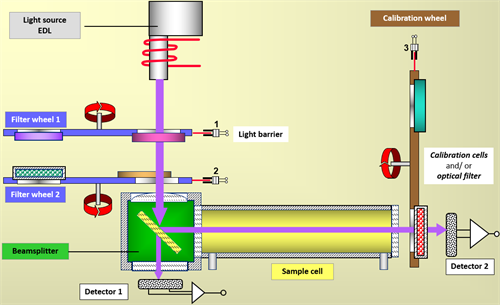Home
- Gas Analysis & Reporting
- Dust monitors
- Flow monitors
- Gas analysers
- Oxygen monitors
Condensate pumps- Coolers
- Filters
- Fittings
- Heated hoses
- Hoses
- Probes
- Sample gas pumps
- Test gasses
- Valves
Reconditioned products- Spare parts
- For analysers
- For gas conditioning
- Batteries
- Circuit boards
- Condensate pumps - spare parts
- Coolers - spare parts
- Filters - spare parts
- Fittings - spare parts
- Fuses
- Gaskets
- Heated hoses - spare parts
- Hoses - spare parts
- O-rings
- Other electrical
- Other mechanical
- PLCs
- Power supplies
- Probes - spare parts
- Relays
- Sample gas pumps - spare parts
- Sensors
- Test gasses - spare parts
- Tools
- Valves - spare parts
- Info pages

 Ultraviolet (UV) light is often used for the analysis of NO, NO2 and SO2. Often, when the UV measuring principle is used it is actually the NDUV (Non Dispersive Ultraviolet) principle. The measurement is made by leading a gas flow through a cuvette where the UV light source and the optical filter have been placed at one end of the cuvette and a detector has been placed at the other end. The UV light source sends out a scattered UV light, and the wave length of the light that is led through the gas in the cuvette is determined by the optical filter installed between the light source and the cuvette. Different kinds of wave lengths of UV light are used to analyse different gasses. The absorption of the light that is sent into the cuvette is an expression of the concentration of the gas to be analysed. The amount of light passing through the gas is measured by the detector at the other end of the cuvette.
Ultraviolet (UV) light is often used for the analysis of NO, NO2 and SO2. Often, when the UV measuring principle is used it is actually the NDUV (Non Dispersive Ultraviolet) principle. The measurement is made by leading a gas flow through a cuvette where the UV light source and the optical filter have been placed at one end of the cuvette and a detector has been placed at the other end. The UV light source sends out a scattered UV light, and the wave length of the light that is led through the gas in the cuvette is determined by the optical filter installed between the light source and the cuvette. Different kinds of wave lengths of UV light are used to analyse different gasses. The absorption of the light that is sent into the cuvette is an expression of the concentration of the gas to be analysed. The amount of light passing through the gas is measured by the detector at the other end of the cuvette.